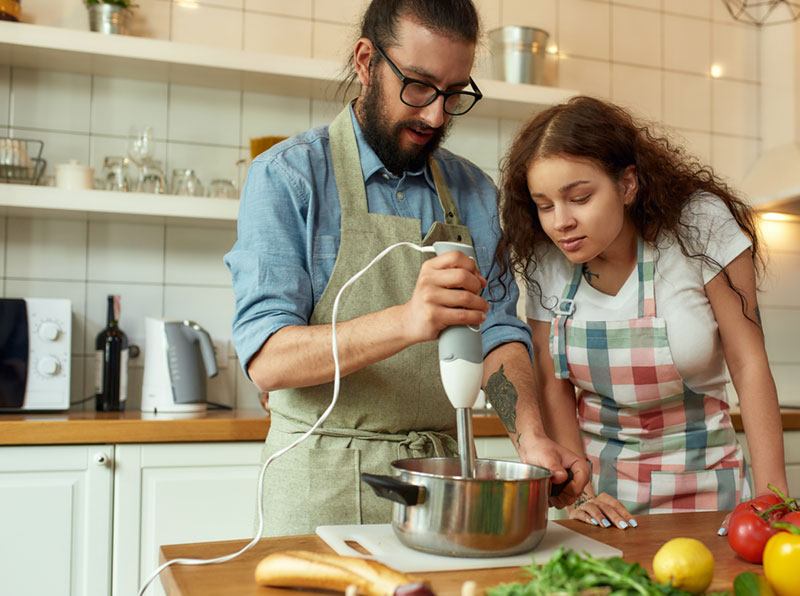Install the right alarms in the right places
To stay safe, it's crucial to install the right type of alarm. Smoke alarms are ideal for most rooms, but kitchens are different as they can be smoky and steamy rooms, therefore a heat alarm is recommended. Unlike smoke alarms, heat alarms detect rapid temperature changes, avoiding false alarms from cooking steam or smoke, e.g. burnt toast.
Key features of heat alarms
- Affordable: Available for around £10 online or at DIY stores
- Options: Choose between battery-powered models you can install yourself or hard-wired ones that require professional installation by an electrician but could be linked to a telecare system for added peace of mind.
- Reliable: Heat alarms will go off if there's a fire, not for burnt food in the kitchen.
If you're not sure if you, or someone you care for, has the right smoke and heat alarms in place to keep safe, use our Home Fire Safety Checker to get advice specific to your home.

Practical steps for safer cooking
Kitchens can be potentially hazardous with bubbling pans, open flames, and the presence of children or pets. To minimise fire risks, follow our top tips:
- Never leave cooking unattended on the hob or grill: if you need to step away from the kitchen, turn off the heat to avoid potential fires.
- Avoid cooking when tired or impaired: if you’re exhausted, have been drinking alcohol, or are on medication that makes you drowsy, it’s safer to skip cooking
- Be mindful of loose clothing: Loose clothing can easily catch fire. Avoid leaning over a hot hob and keep tea towels and cloths away from the cooker and hob.
- Keep your cooking area clean: Regularly clean the oven, hob, cooker hood, extractor fan, and grill. Accumulated fat and grease can ignite and cause a fire.
- Double-check appliances are turned off: Ensure that the cooker and hob are switched off when you finish cooking.
- Maintain toasters properly: Keep toasters clean and avoid placing them under kitchen cabinets or near anything that could catch fire.
- Avoid metal in the microwave: Never put metal objects in the microwave as they can cause sparks or fires.
- Supervise children and pets: Always keep an eye on children and pets in the kitchen. Keep matches and lighters out of their reach and ensure saucepan handles are positioned away from the edge of the stove.
What to do if your clothes catch fire?
If your clothes catch fire, it is crucial to stay calm and follow these steps: ‘stop, drop, roll':
- Stop: Do not run, as this can make the flames spread more quickly.
- Drop: Immediately lie down on the ground to minimise the flames’ reach.
- Roll: Roll on the ground to help extinguish the flames. If possible, cover yourself with a heavy fabric or a fire blanket to smother the fire. Even rolling on the ground alone can help.
Remember, staying calm and acting quickly can significantly improve your chances of safety.

Assistive technology for the kitchen
There's a wide range of tools available to make your kitchen safer, from timers that switch off a hob automatically, to cooker guards. These aids can be especially helpful for people who have difficulties with their memory, mobility, vision or hearing.
Take a look at the Living Made Easy website to see what's available.
Cost-saving cooking
We understand that the rising cost of living is a concern, but it's important to ensure that any changes you make in the kitchen are safe. Here are some simple ways to save money on your energy bills:
- Use a slow cooker: Slow cookers use much less power compared to a conventional oven—about as much as a light bulb—so switching to a slow cooker can help you save on energy costs.
- Boil only what you need: When using a kettle, only boil the amount of water you actually need. This reduces energy consumption.
It is never safe to use any type of outdoor cooking equipment like a BBQ or camping stoves indoors. Doing so, poses a serious risk of fire and deadly carbon monoxide poisoning.
For more tips, you may want to check websites like Money Saving Expert, or with your gas and electricity provider.

Check your home's safe using our simple tool
It only takes a few minutes to check your home and get tailored advice for your family.
Helen explains safety tips to remember when cooking in BSL.
